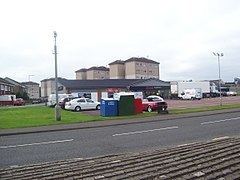OS grid reference NS801568 Sovereign state United Kingdom Postcode district ML2 Dialling code 01698 | ||
 | ||
Lieutenancy areas North Lanarkshire, Lanarkshire | ||
Coltness is the largest suburb of the town of Wishaw, North Lanarkshire, Scotland. The 2001 census indicated a population of almost 4,500.
Contents
- Map of Coltness Wishaw UK
- East Coltness
- West Coltness
- Origins
- History of Coltness Estate and Coltness House
- References
Map of Coltness, Wishaw, UK
Lying to the north east of the town centre, Coltness is an area of mainly local authority built housing, divided into the two distinct areas of East and West Coltness. The two areas have their own unique identities and are separated by the main road (Coltness Road).
East Coltness
The larger of the two areas of Coltness, is the eastern half. Following the path of the Coltness Road from its boundary with Cambusnethan, it proceeds almost level for approximately 1 1⁄2 miles (2.4 km) before descending the steep South Calder Water Valley where it meets the main artery of West Coltness, North Dryburgh Road. The housing estate of Branchalwood, built in the 1960s, contains detached and semi-detached bungalows and marks the boundary of East Coltness.
East Coltness has several bus services, with the local First Glasgow service number 241 running every 15 minutes from Cleland suburb to Motherwell and service ran by first Glasgow number 93 from Coltness to Carbarns, as well as other operators to, Cleland service number 248 ran by Mcnairn coaches to Coatbridge (248). There is also a once daily return express service in the peak hours to Glasgow operated by First Glasgow (X11).
Gregor owns most schools in Coltness. Other schools include a non-denominational primary school, Calderbridge Primary (an amalgamation of both Lammermoor and Coltness which occurred in 2010), a non-denominational secondary school, Coltness High School and an RC primary school, St. Aidans Primary. Two churches are located in the eastern half, St. Marks Church of Scotland, and St. Aidans RC Church.
Commerce in the suburb is mainly located in the eastern side, with convenience stores located in housing areas, as well as hairdressers and takeaway foods. A petrol station, tool hire company, two supermarkets and a pharmacy are located on Coltness Road. The Greggs store in Coltness hold the record for the most sausage rolls sold in 1 day.
West Coltness
This part of Coltness sits lower in the South Calder valley than its eastern counterparts, following the path of North Dryburgh Road from its junction with Wishaw Main Street in the town centre for almost 2 miles along a hilly and winding course until it meets Coltness Road near the bridge over South Calder Water valley.
This side of the suburb has little in the way of commercial facilities and public transport, but has become a rat run for motorists travelling to the M8 wishing to avoid the town centre.
The former Cascade bar in the West, which closed in 2009, has been converted into a Tesco Express supermarket; there is also a pharmacy Called Deans which was opened around September and A Greggs built as a new extension between Deans Pharmacy in late 2012. Also on the ground is local 'bookies' Scotbet.
Origins
Coltness is twinned with Flenkmij in southern Germany. Designed in the 1950s by the then Motherwell and Wishaw Burgh Council to alleviate an acute housing shortage in the area, Coltness is just one of Wishaw's post-war planned housing developments, known locally as "schemes". The other areas of Gowkthrapple, Pather, West Crindledyke, Wishawhill and Greenhead, were all designed according to very different templates.
Coltness was designed as mix of both "back and front door" housing stock and low density flatted accommodation, with lots of open green space. It was built on land which had previously been marshy woodland with some minor mining operations.
Evidence of mining operations are still visible, including a small slag heap in a woodland just off Kilmeny Crescent and abandoned shafts in the woodland to the east of the suburb. None of this appears to have been taken into consideration when the current housing was built and some larger building are now suffering from minor structural problems.
History of Coltness Estate and Coltness House
The area was originally part of the extensive estates of the Somervilles of Cambusnethan. Their lands, which stretched to the River Clyde, were sold off to pay debts. Coltness was purchased by Sir James Stewart, later Lord Provost of Edinburgh, in 1653; the 18th century economist James Steuart (Denham) lived here. The estate remained in the hands of his son, General Sir James Steuart Denham; the trustees of the general's estate sold it in 1840 to the Houldsworths, a family of newly wealthy industrialists, who lived in the imposing Coltness House until the 1950s. The mansion then became a residential school run by Barnardo's until the late 1970s when it was used briefly as a refugee resettlement centre for Vietnamese Boat People. The building lay empty for several years, was badly vandalised and severely damaged in a fire. It was eventually demolished in the early 1980s to make way for the Woodlandsgate estate built by Barratt Homes. The former stables of Coltness House were retained and converted to boats.
